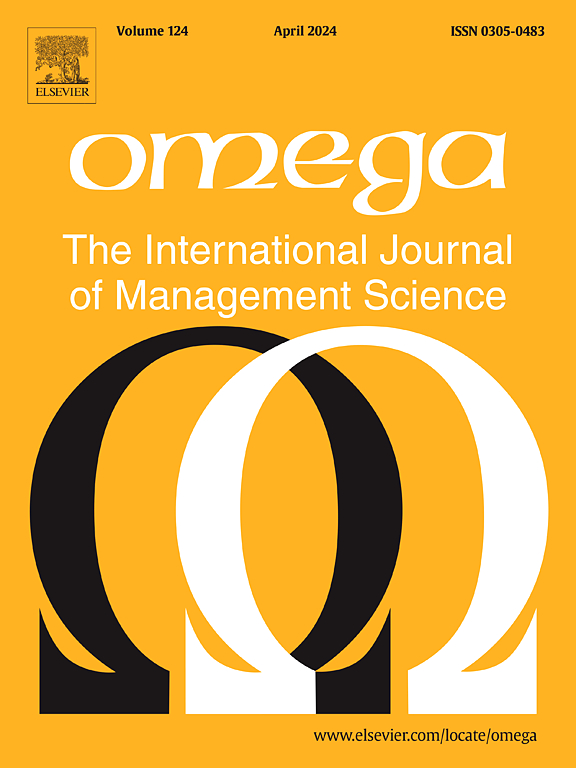衡量不同群体之间生产力差距的新方法:来自巴塞罗那和皇家马德里的历史足球运动员的应用程序
IF 7.2
2区 管理学
Q1 MANAGEMENT
Omega-international Journal of Management Science
Pub Date : 2025-09-02
DOI:10.1016/j.omega.2025.103421
引用次数: 0
摘要
在生产分析领域,评估在不同环境下操作相同生产过程的两组或多组生产单元之间的生产率差距是一个共同的挑战。这些小组需要决定他们是否应该继续以同样的方式运作,以维持其较好的业绩水平,或者决定应该改变哪些管理做法,以缩小与其他小组最佳做法之间的差距。本文的目的是提出一种新的工具,用于测量不同组之间的生产力差距,该工具基于在单位超立方体内均匀分布的合成参考组的使用。此外,由于生产率差距可以分解为效率差距和整体技术差距两部分,因此该方法可以实现循环测试,并且不依赖于基础参考技术。因此,它优于其他传统方法。为了说明这种方法的实用性,我们分析了西班牙足球的两个最大的竞争对手俱乐部:巴塞罗那足球俱乐部和皇家马德里足球俱乐部之间的生产力差距。我们使用两家俱乐部历史上最重要球员的表现数据,根据他们在球场上的位置进行划分。分析的时间段涵盖了过去70年,从欧洲赛事开始到现在,即从1954/55赛季到2023/24赛季。结果表明,迄今为止,皇马的守门员和中场球员的生产力高于效力于巴萨的球员,后卫的生产力与效力于巴萨的球员持平,而巴萨的前锋的生产力高于效力于皇马的球员。本文章由计算机程序翻译,如有差异,请以英文原文为准。
A new approach for measuring productivity gaps across groups: an application with historic footballers from FC Barcelona and Real Madrid
The assessment of the productivity gap between two or more groups of production units that operate an equivalent production process in different settings is a common challenge in the field of production analysis. These groups need to determine whether they should keep operating in the same manner to sustain their better performance levels or decide which managerial practices should be altered to close the gap with respect to best practices in other groups. The aim of this paper is to propose a new tool for measuring the productivity gap across different groups based on the use of a synthetic reference group uniformly distributed within a unit hypercube. Besides, as the productivity gap can be decomposed into two components, efficiency gap and global technical gap, this method fulfills the circular test and is independent of a base-reference technology. Thus, it outperforms other traditional approaches. To illustrate the usefulness of this methodology, we analyze the productivity gap between Spanish football’s two biggest rival clubs: FC Barcelona and Real Madrid. We use data on the performance of the most important players in the history of both clubs, divided according to their position on the pitch. The period of analysis covers the last 70 years, from the beginning of European competitions to the present day, i.e., from the 1954/55 to the 2023/24 season. Results show that, to date, Real Madrid’s goalkeepers and midfielders were more productive than those playing for FC Barcelona, there is a tie for defenders, while the productivity of FC Barcelona’s forwards was higher than those playing for Real Madrid.
求助全文
通过发布文献求助,成功后即可免费获取论文全文。
去求助
来源期刊

Omega-international Journal of Management Science
管理科学-运筹学与管理科学
CiteScore
13.80
自引率
11.60%
发文量
130
审稿时长
56 days
期刊介绍:
Omega reports on developments in management, including the latest research results and applications. Original contributions and review articles describe the state of the art in specific fields or functions of management, while there are shorter critical assessments of particular management techniques. Other features of the journal are the "Memoranda" section for short communications and "Feedback", a correspondence column. Omega is both stimulating reading and an important source for practising managers, specialists in management services, operational research workers and management scientists, management consultants, academics, students and research personnel throughout the world. The material published is of high quality and relevance, written in a manner which makes it accessible to all of this wide-ranging readership. Preference will be given to papers with implications to the practice of management. Submissions of purely theoretical papers are discouraged. The review of material for publication in the journal reflects this aim.
 求助内容:
求助内容: 应助结果提醒方式:
应助结果提醒方式:


